
Picture a bowl of creamy butternut squash soup that’s like a warm hug from the inside out on those crisp autumn nights. We’re talking about the good stuff here – butternut squash, carrots, onions, and celery, all mingling together in one pot to create a deliciously creamy masterpiece.
But here’s the kicker – it’s not just yummy, it’s packed with all the good-for-you stuff your body craves. So whether you’re flying solo and cozying up for some self-care, or you’re playing chef for your loved ones on a chilly day, this soup is your go-to for comfort and nourishment.
And let’s not forget the best part – it’s a breeze to make. You don’t need to be a culinary genius to whip up a batch of this goodness. So whether you’re a seasoned home chef or more of a “takeout expert,” this soup is your ticket to a satisfying meal that’ll have you feeling all warm and fuzzy inside.
Enjoy it on those cozy nights in, or share the love with your favorite people – it’s a bowl of comfort that’s perfect for any occasion!
What You’ll Love About This Recipe
Detailed Ingredient Notes
In this section, I have provided some detailed notes on some of the ingredients used in this recipe. For more detailed substitution suggestions, see the Substitutions section below.
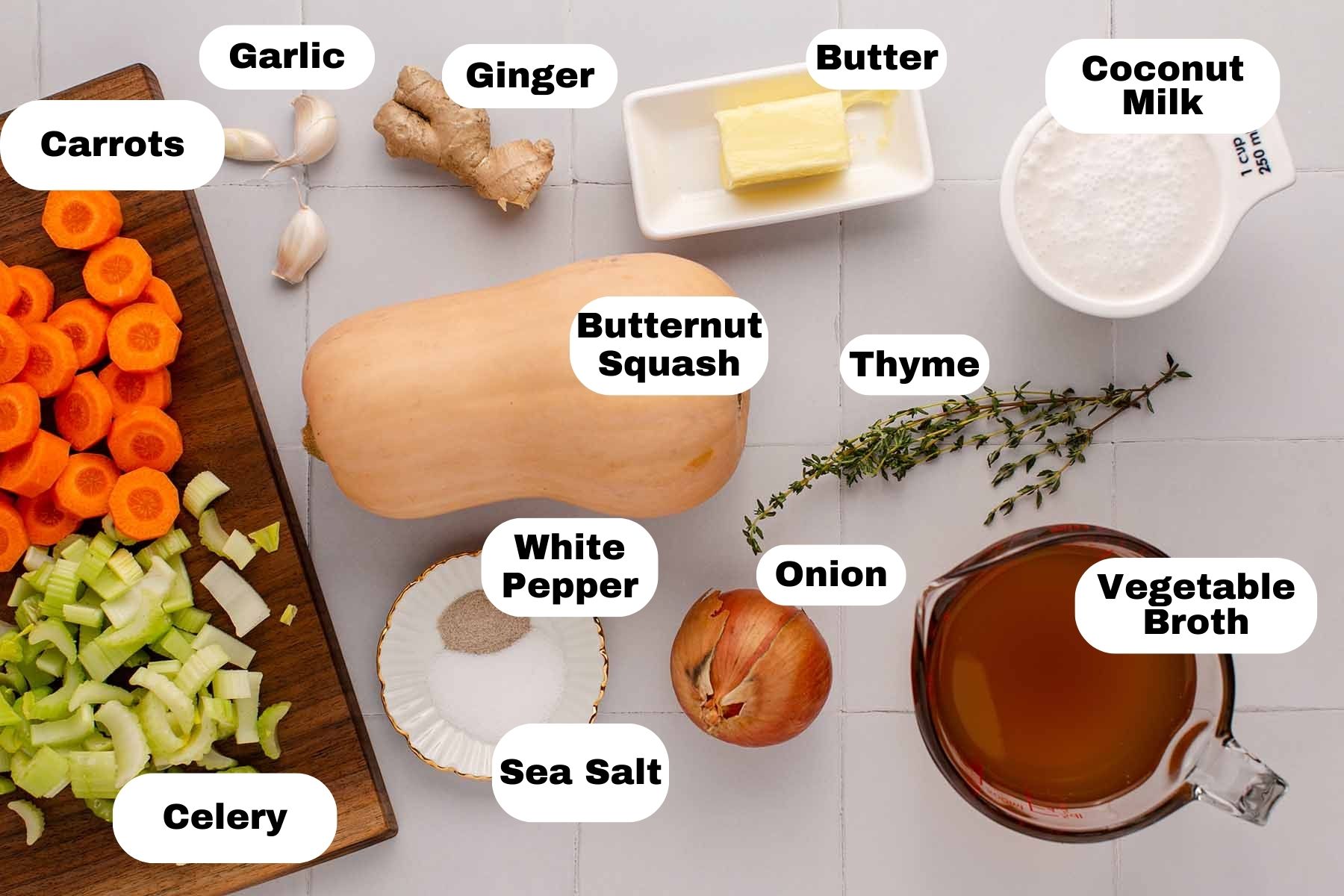
- Unsalted butter. In this recipe, we use unsalted butter to have more precise control over the saltiness. However, if you only have salted butter available, it’s absolutely fine to use it as a substitute. Just keep in mind that you may need to tweak the amount of salt you include in the soup. So, give it a try, and season it with salt according to your taste preferences.
- Large onion. Diced. For this recipe, opt for a yellow onion as it’s the ideal choice. Yellow onions bring a blend of slight sweetness and savory notes that perfectly complement butternut squash soup. If you would like, you can certainly swap in a white onion. This choice provides a milder onion flavor. For those craving an even sweeter soup, consider using a sweet onion variety such as Vidalia or Walla Walla.
- Garlic. Minced.
- Fresh ginger. Chopped. You can swap in ½ to 1 teaspoon of ground ginger. For the fresh ginger, you can peel it or not because the skin is edible. For this soup, no need to peel because the simmering will make the skin tender. But if prefer to peel it, a spoon is the best tool for the job. Check out my spicy chicken soup post for a quick demo.
- Sea salt. In this recipe, we’re using sea salt, which has a milder saltiness compared to regular table salt. If you decide to go with table salt instead, no problem, but remember to use less of it. Begin with ¾ teaspoon, and then fine-tune the saltiness based on your taste.
- White pepper. This soup specifically uses white pepper for a couple of good reasons. First, I wanted the final dish to have a uniform color, so no black pepper specks would pop up. And second, white pepper brings a milder flavor compared to black pepper. In a subtle soup like butternut squash, this gentler touch lets the natural sweetness of the squash take the spotlight.
- Fresh thyme leaves. 3 to 4 sprigs. You can sub 1½ teaspoons dried thyme leaves. In step 5 of the recipe (during the simmering stage), I added fresh thyme sprigs. If you prefer not to handle the woody stems later, you can strip the leaves off the stems and mix them in at this point. Alternatively, you can choose to use dried thyme leaves in this recipe. If you opt for dried thyme leaves, simply introduce them during step 3 when you’re pre-cooking the vegetables.
- Large butternut squash. About 3 to 4 pound size. Peeled and cut into 1-inch cubes (about 6 cups). Is it necessary to peel the butternut squash? Not necessarily. Technically, the skin is edible. But, my suggestion is to peel it. Why? Well, peeling gives the final dish a smoother texture. The decision is entirely yours. If time’s not on your side, go ahead and keep the skin. Just remember, sometimes it can lead to little specks in the soup, so it might not look exactly like the photos in this recipe post.
- Canned coconut milk. For this recipe, we’re using full-fat canned coconut milk. You’ll typically locate it in the Asian section of your grocery store. Now, please note, the coconut milk found in cartons near regular milk won’t do the trick here. It’s the canned coconut milk that gives us that rich creaminess we’re after.
Instructions
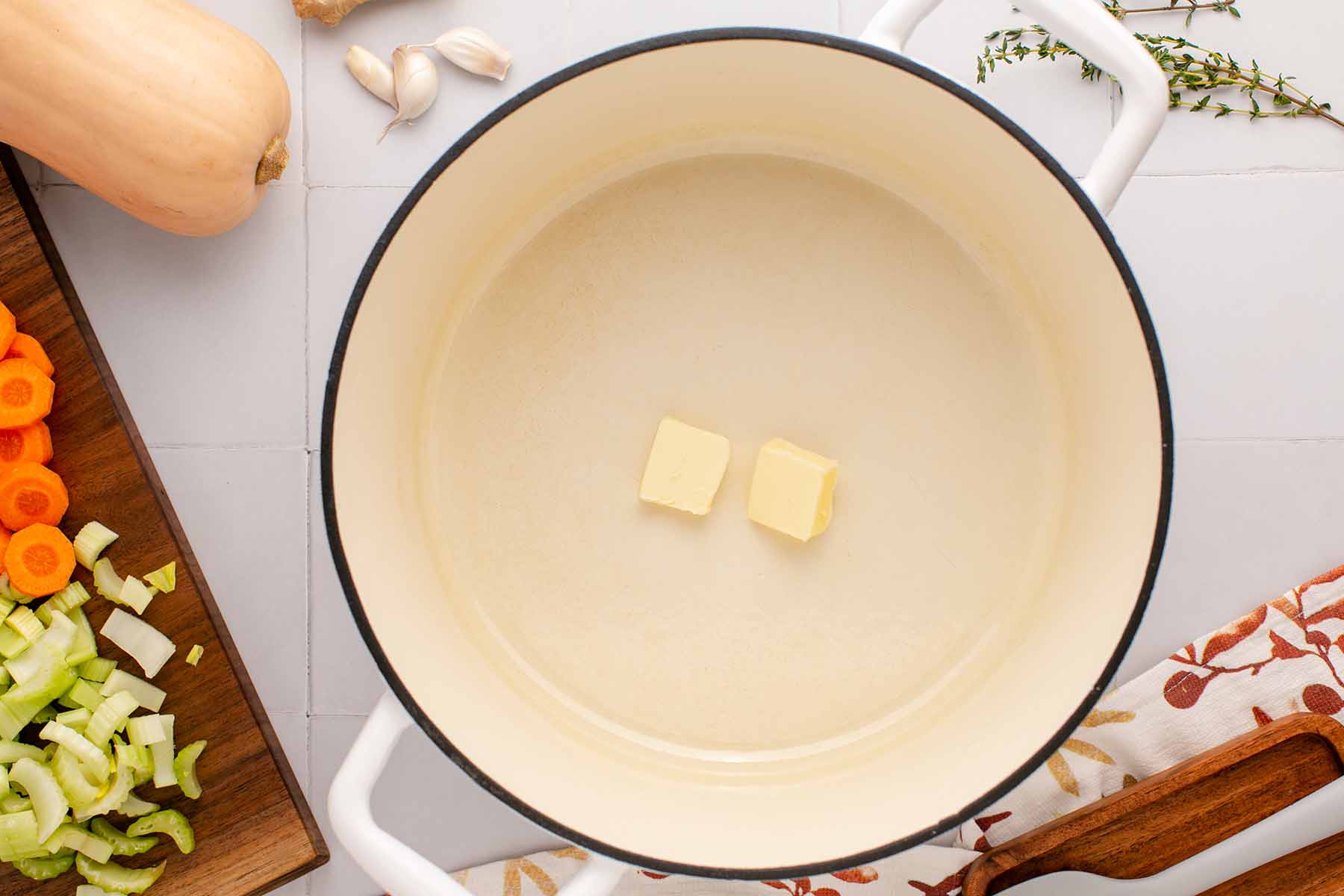
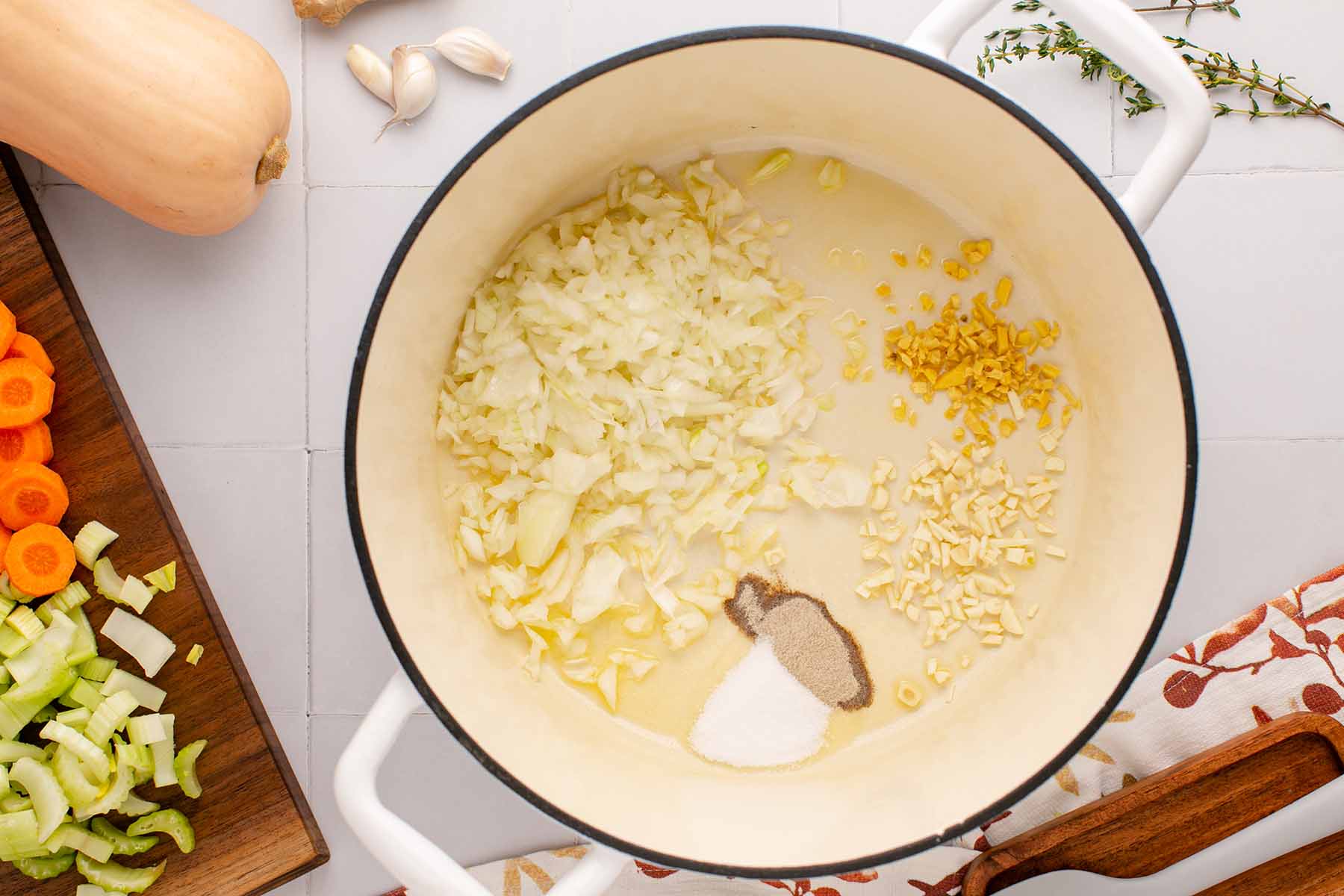
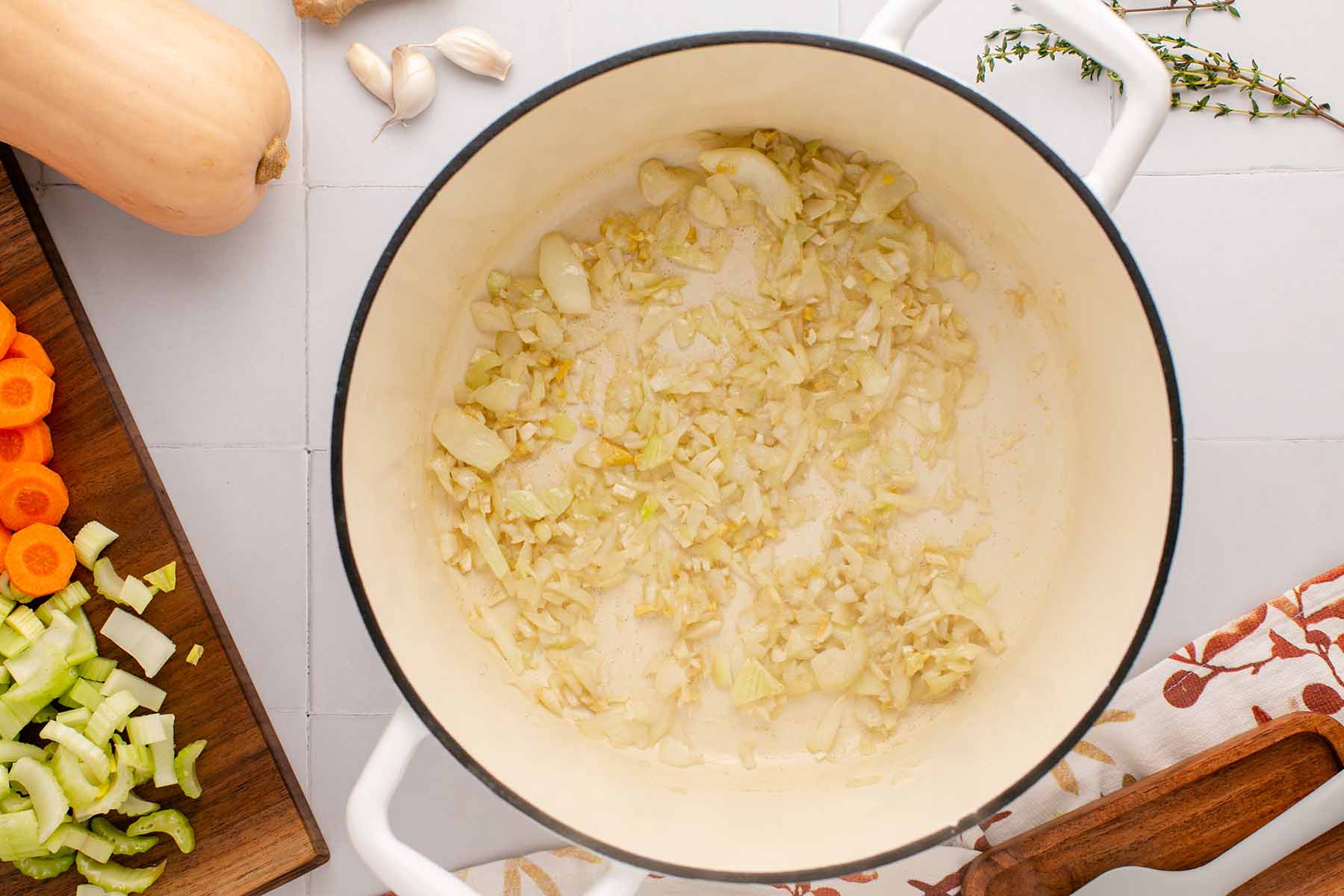
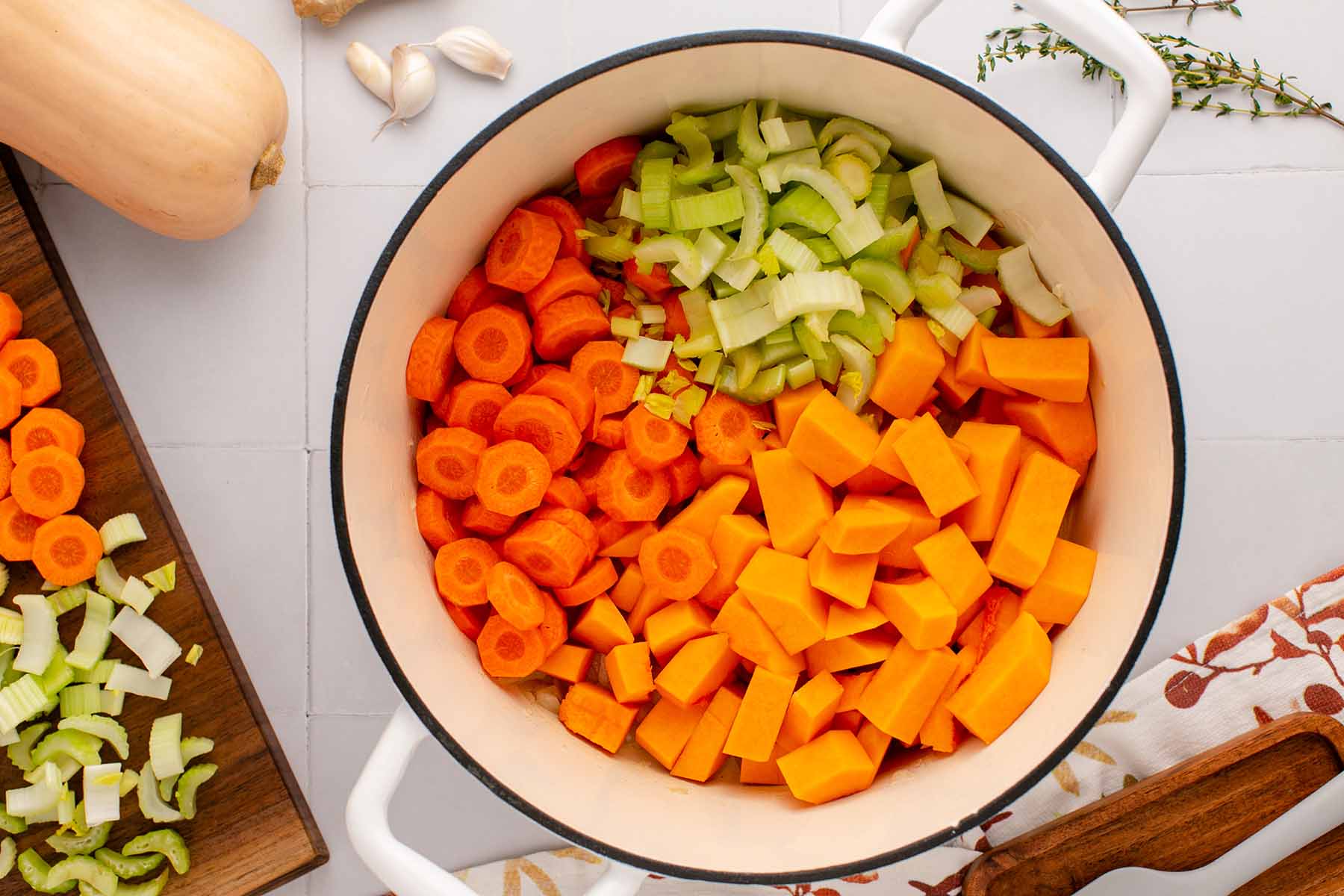
If you are substituting dried thyme leaves, add it at this step.
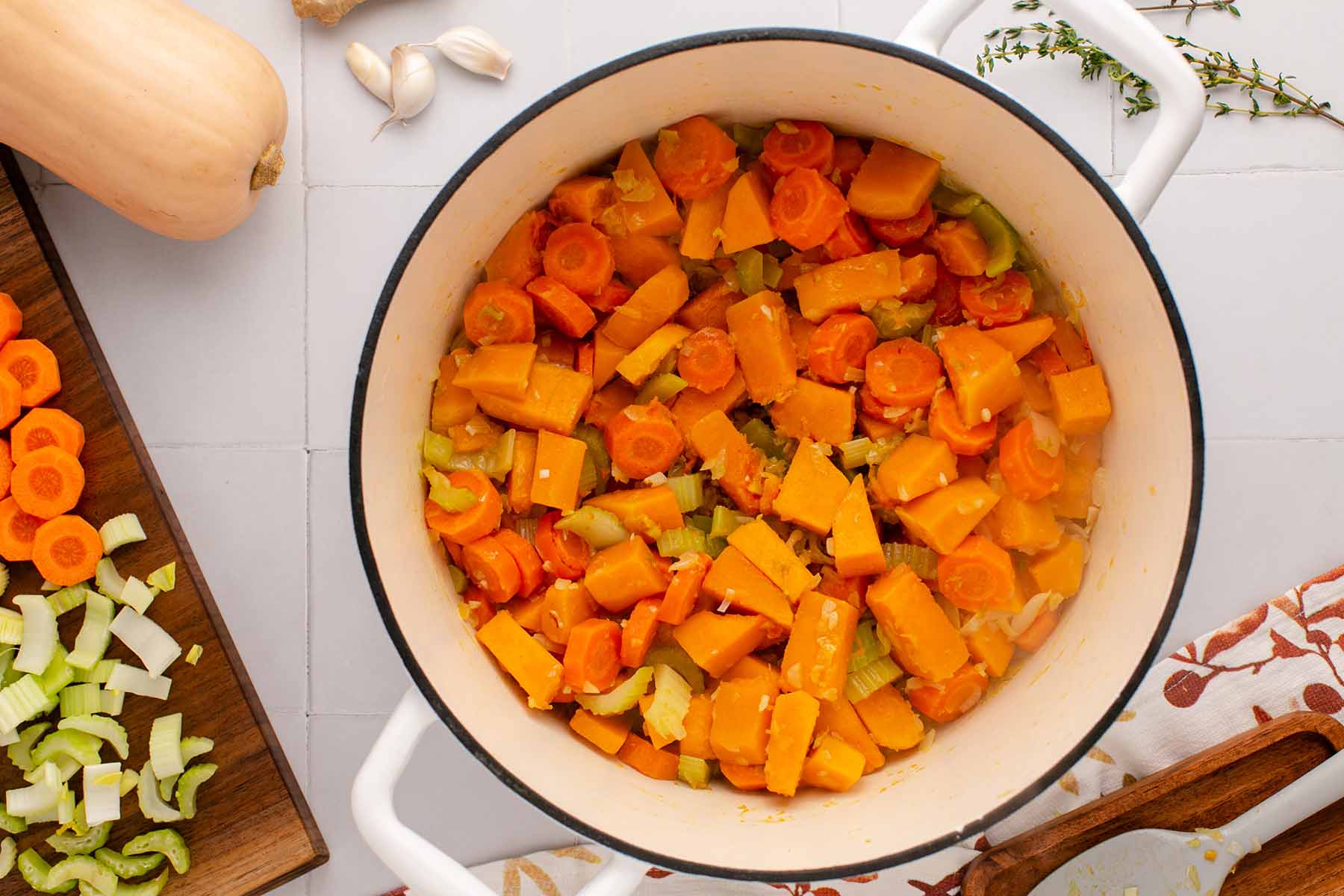
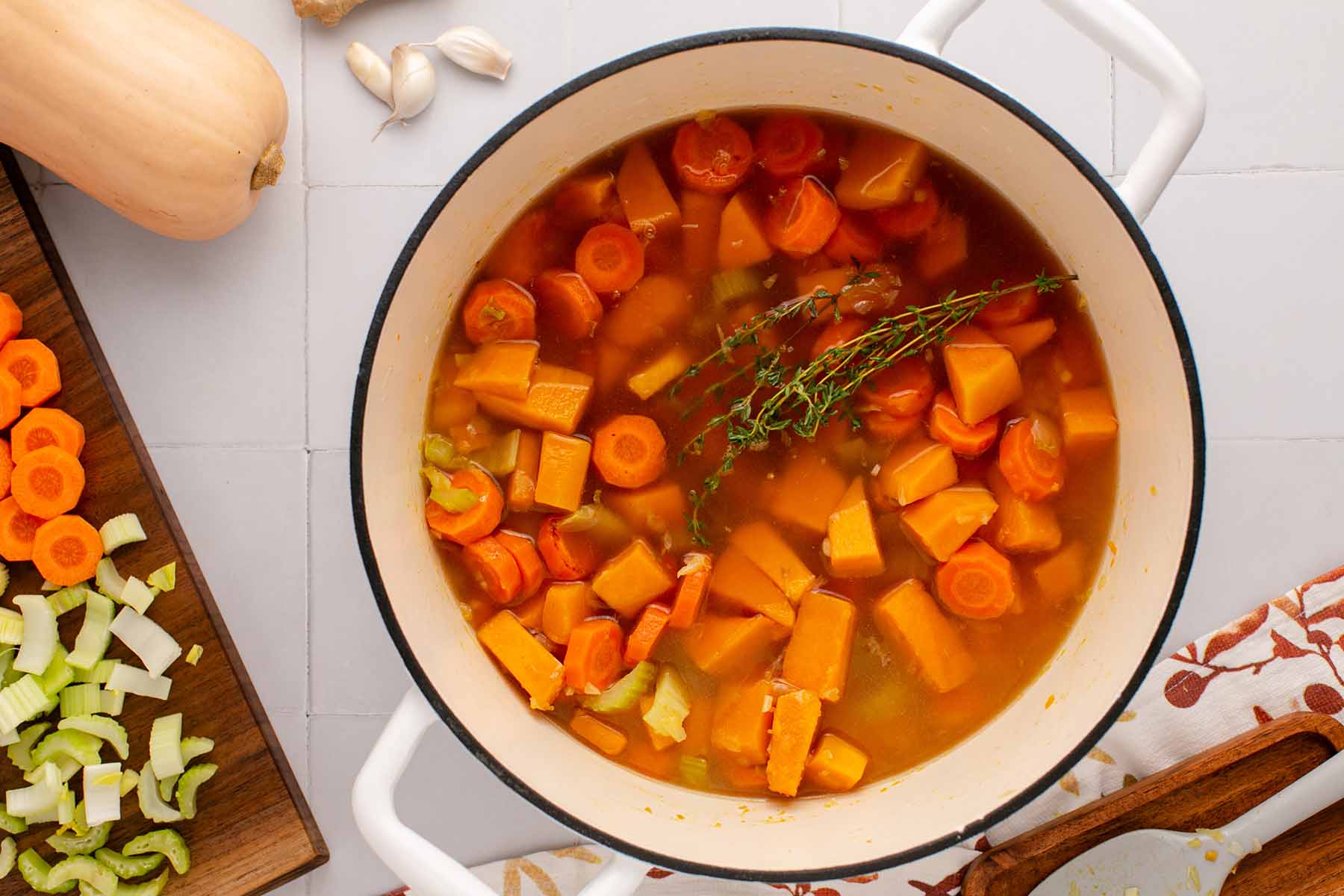
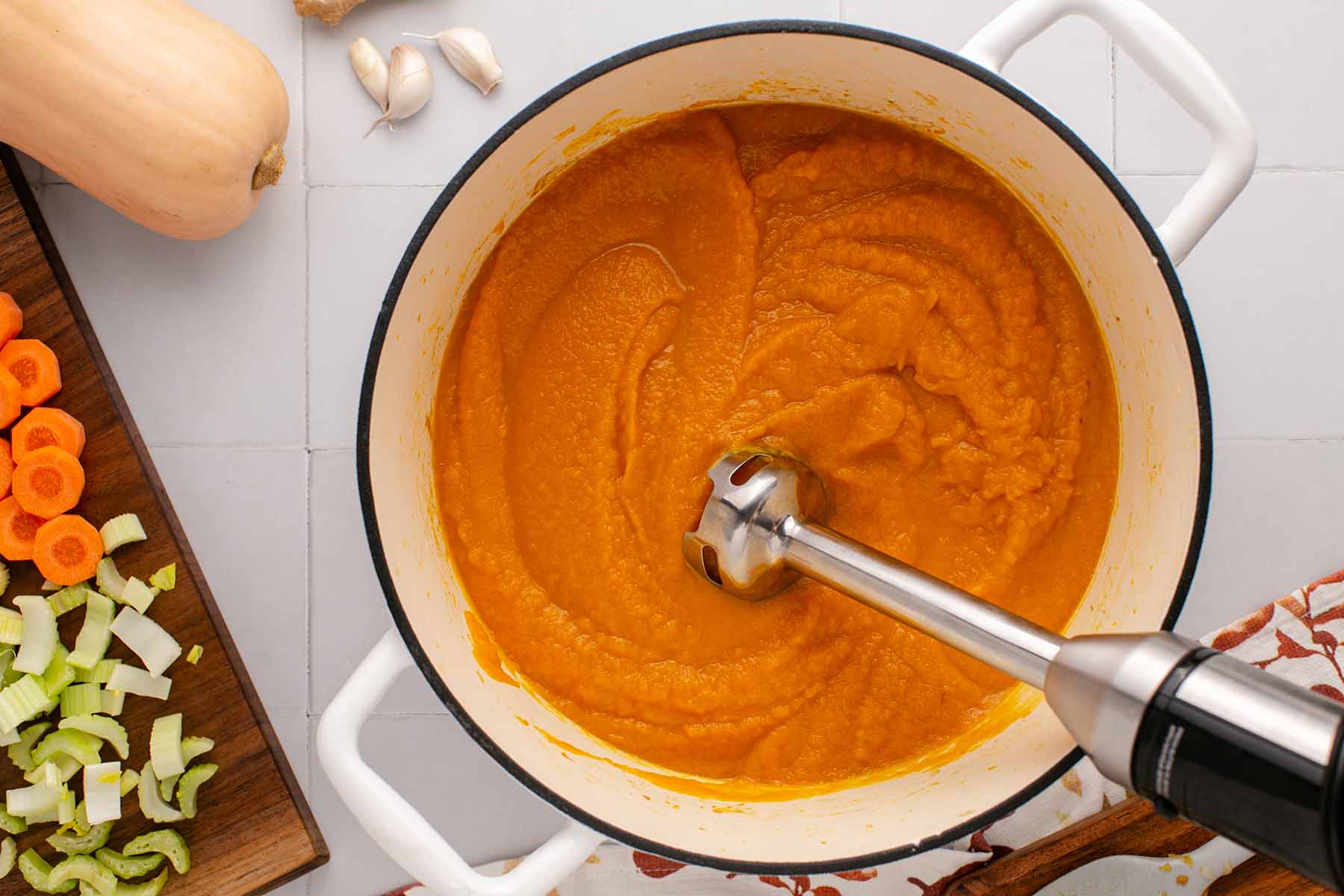
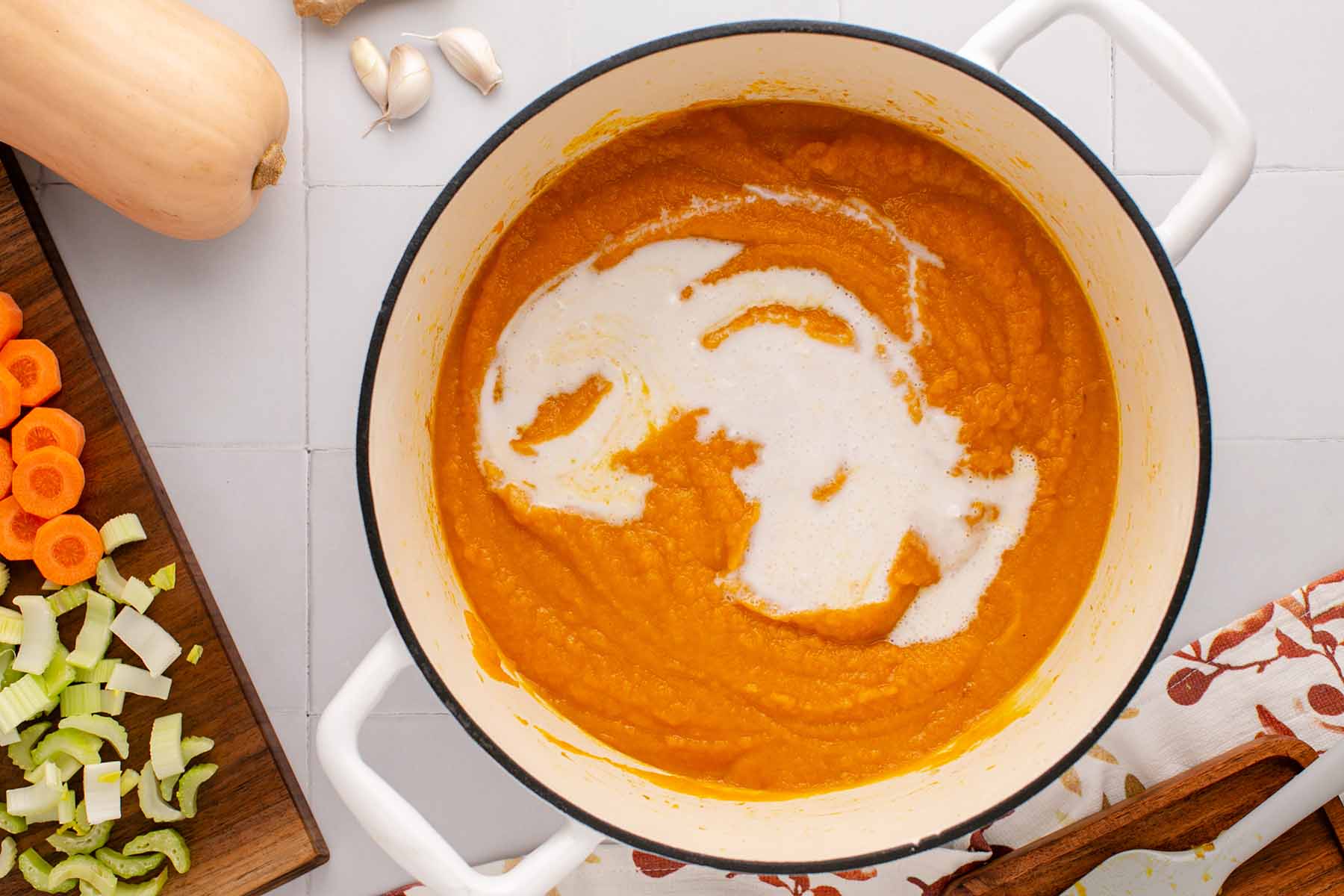
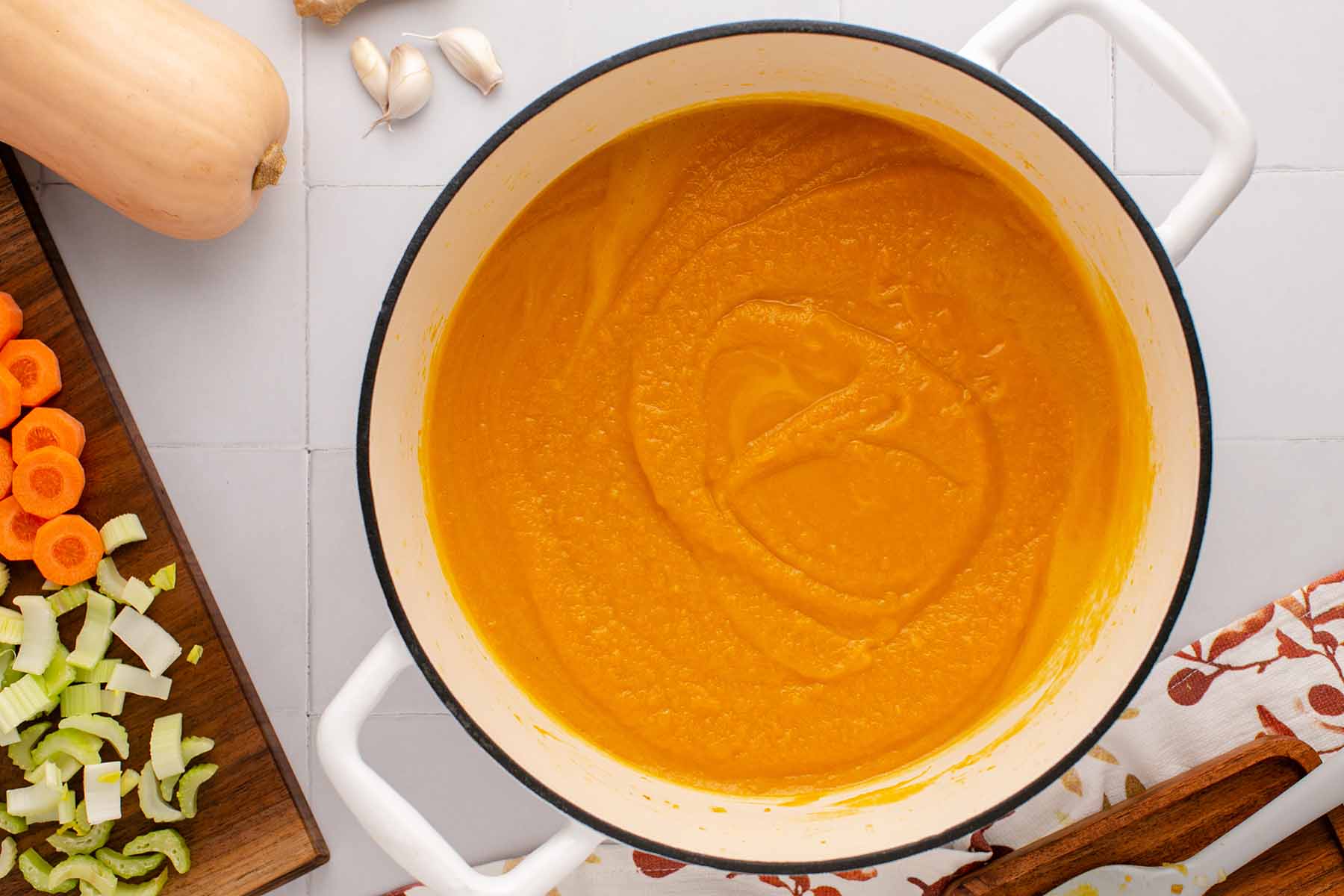
Substitutions
If you are looking to make ingredient substitutions, I hope this information is helpful. Do not hesitate to ask questions before making any substitutions. I’m happy to help!
These substitutions may slightly alter the flavor and texture of the dish slightly, but they should work well in a pinch.
Would you like to save this recipe?
- Butter. You can substitute unsalted butter with olive oil, ghee, or a plant-based butter for a dairy-free option.
- Onion. If you’re out of onions, you can use shallots or leeks as a flavorful alternative.
- Fresh Ginger. Ground ginger is a good substitute for fresh ginger. Use ½ to 1 teaspoon of ground ginger.
- Sea Salt. Regular table salt can be used in place of sea salt. You will likely need to reduce the amount. Start with ¾ teaspoon and adjust accordingly.
- White Pepper. Black pepper is a suitable substitute for white pepper if you don’t have it. Use it in the same quantity.
- Fresh Thyme. 1½ teaspoons dried thyme leaves can be used as a substitute for fresh thyme.
- Coconut Milk. If you prefer not to use coconut milk, you can substitute with other dairy or non-dairy cream alternatives like heavy cream or cashew cream. Adjust the amount based on desired creaminess.
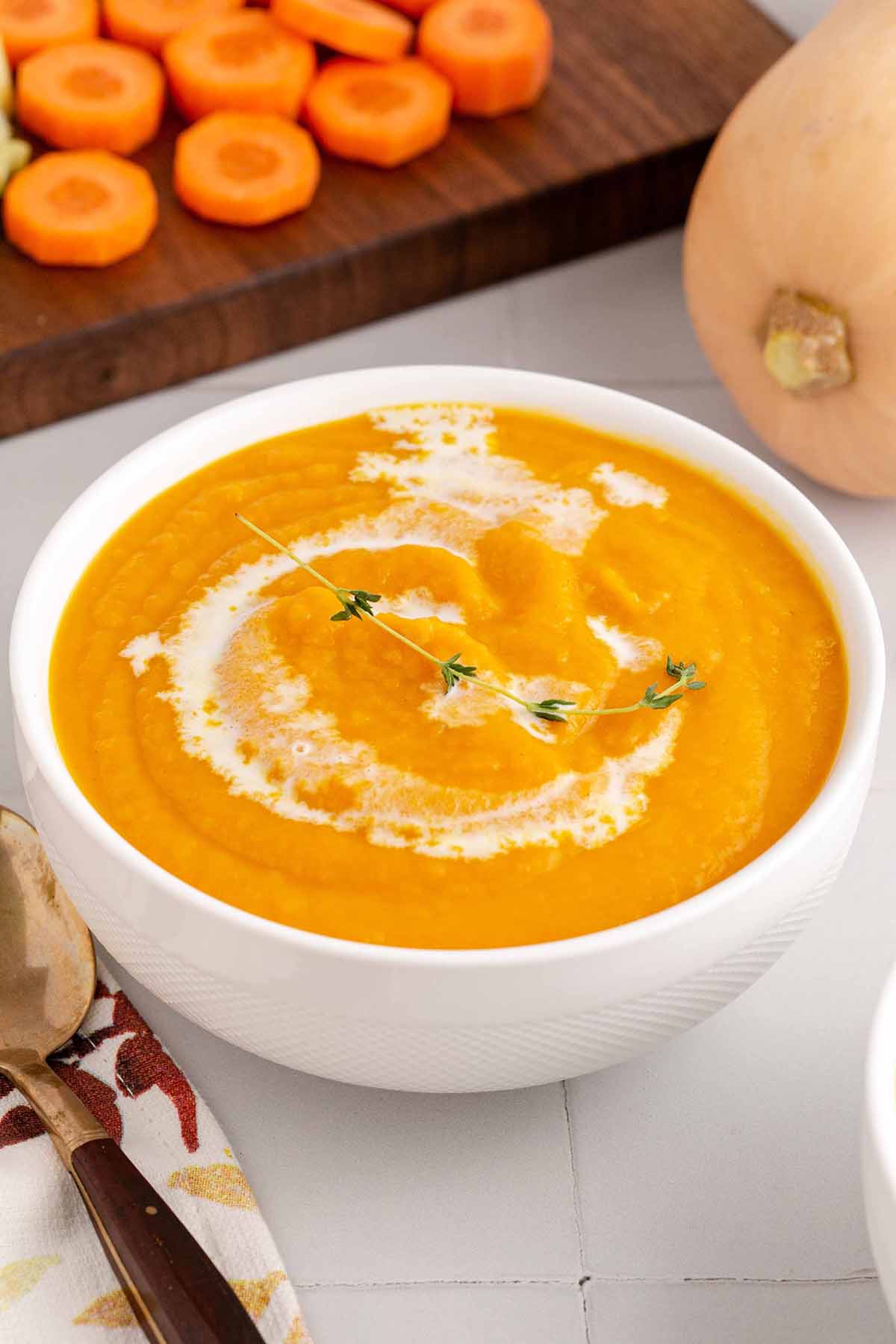
Top Tips
- Sauté the Aromatics Well. Be sure to cook the onions, garlic, and ginger until they’re soft and fragrant before adding the squash and other vegetables. This step helps to build a rich base flavor for your soup.
- Deglaze the Pot (Optional). After cooking the vegetables, you can deglaze the pot with a splash of vegetable stock before adding the rest of the stock. This will help lift any flavorful bits stuck to the bottom of the pot.
- Blend Carefully. When using an immersion blender, blend the soup until it’s completely smooth. If you’re using a regular blender, blend in batches and be careful with hot liquids to avoid spills.
- Simmer Gently. Once you add the stock, make sure to simmer the soup gently. A vigorous boil can break down the vegetables too quickly and affect the texture of the soup.
- Adjust Consistency. If the soup is too thick after blending, you can adjust the consistency by adding a bit more vegetable stock or coconut milk.
- Roast the Squash (Optional). For added depth of flavor, consider roasting the butternut squash before adding it to the pot. Toss the cubes with a bit of olive oil, salt, and pepper, and roast at 400 F (200 C) for 20-25 minutes until caramelized.
- Use High-Quality Stock. The flavor of your soup largely depends on the stock you use. Opt for a high-quality vegetable stock or homemade stock for the best results.
- Incorporate Apple or Pear. Adding a peeled and chopped apple or pear to the pot with the squash can introduce a subtle sweetness that complements the butternut squash.
Storage
Storing:
- Allow the soup to cool to room temperature.
- Transfer it to an airtight container or a resealable plastic bag. Be sure to leave some space at the top as soup tends to expand when frozen.
- Seal the container tightly to prevent freezer burn.
- Label the container with the date to keep track of freshness.
- Store in the refrigerator for up to 3-4 days or in the freezer for 2-3 months.
Reheating:
- To reheat refrigerated soup, simply pour it into a pot and warm it over medium heat. Stir occasionally until it’s heated through. You can add a splash of water or broth if it’s too thick.
- To reheat frozen soup, first thaw it in the refrigerator overnight. Then, reheat it on the stovetop over medium-low heat, stirring occasionally until it’s thoroughly heated.
Avoid reheating butternut squash soup in the microwave, if possible, as it can cause uneven heating and texture changes. Stovetop reheating is generally the best method for preserving the soup’s creamy consistency.


Related Recipes
Looking for more soup recipes? Give these a try:
Pairing
These are my favorite dishes to serve with this squash soup:
Creamy Butternut Squash Soup Recipe
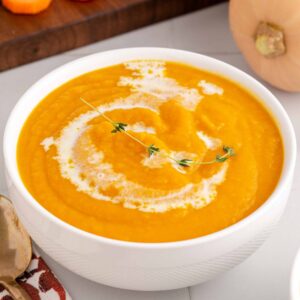
Equipment
Ingredients
- 2 tablespoons butter Unsalted. See Note 1.
- 1 large onion Diced. Note 2.
- 3 teaspoons garlic Minced.
- 2 teaspoons fresh ginger Chopped. Note 3.
- 1½ teaspoons sea salt Note 4.
- ½ teaspoon white pepper Note 5.
- ½ teaspoon fresh thyme leaves 1 to 2 sprigs. You can sub 1½ teaspoons dried thyme leaves. Note 6.
- 1 large butternut squash Peeled and cut into 1-inch cubes (about 6 cups). Note 7.
- 2 celery stalks Roughly chopped. About 1.5 cups.
- 2 medium carrots Roughly chopped. About 2.5 cups.
- 4 cups vegetable stock
- 1 cup coconut milk Full fat canned coconut milk. Note 8.
Instructions
- Melt butter in a large pot over medium heat.2 tablespoons butter
- Add onion, garlic, ginger, salt, and pepper. Stir and cook until the onion is soft. Note 9.1 large onion, 3 teaspoons garlic, 2 teaspoons fresh ginger, 1½ teaspoons sea salt, ½ teaspoon white pepper, ½ teaspoon fresh thyme leaves
- Add squash, celery, and carrots and cook for 15 minutes, stirring occasionally.1 large butternut squash, 2 medium carrots, 2 celery stalks
- Pour stock into the pot and bring to a boil.4 cups vegetable stock
- Once boiling turn heat down to low. Add the fresh thyme sprig(s). Simmer for 15-20 minutes, or until carrots are soft.
- Remove from heat. Strip any remaining leaves from the thyme sprigs and drop the leaves back into the pot. Discard the woody stems. Puree the soup with an immersion blender.1 cup coconut milk
- Stir in the coconut milk.
- Serve warm and add garnishes if desired.
Notes
- This recipe calls for unsalted butter to provide better control over the salt content. If you only have salted butter on hand. It’s okay to substitute salted butter, but you will likely need to adjust the amount of salt you add to the soup. Give it a taste and adjust the amount of salt as desired.
- A yellow onion would work best in this recipe. They have a slightly sweet and savory taste that works well in butternut squash soup recipes. In addition, they provide a subtle onion flavor without overpowering the sweetness of the squash. If you prefer, you can substitute a white onion. It’s a good choice if you want a more delicate onion presence in your soup. For a sweeter soup, go for a sweet onion variety, like Vidalia or Walla Walla.
- You can substitute ½ to 1 teaspoon of ground ginger.
For the fresh ginger, because the ginger skin is edible, you can take the time to peel the ginger or not. The choice is yours. For this soup, peeling the ginger is an unnecessary step because the simmering will soften the skin. If you do choose to peel it, the easiest way is with a spoon. I demonstrate how to do this in my spicy chicken soup post. - This recipe calls for sea salt. Sea salt is less salty than regular table salt. You can substitute regular table salt, but you will need to use less. Start with ¾ teaspoon and adjust from there according to your preference.
- This soup calls for white pepper for two reasons: color and flavor. I didn’t want any black pepper granules to show in the finished dish. White pepper also has a milder flavor than black pepper. In a delicate soup like butternut squash, white pepper’s milder flavor allows the sweetness of the squash to shine through more prominently.
- I used fresh thyme sprigs in step 5 of the recipe (the simmering stage). If you don’t want to deal with the woody stems later, you can strip the leaves off of the stems and stir them in at this stage.
You also have the option of substituting 1½ teaspoons dried thyme leaves in this recipe. If you substitute dry thyme leaves, add them at steps 2 or 3 when you are pre-cooking the vegetables. - Do you have to peel the butternut squash? Not really. The skin is edible. However, I do recommend peeling it so that the final product has a smoother texture. However, the choice is yours. If you’re pressed for time, go ahead and leave the skin on, but bear in mind that the skin can sometimes result in specks in the soup so that it would not look exactly like the photos in this recipe post.
- This recipe calls for full fat canned coconut milk. You can usually find this in the Asian section of your grocery store. The coconut milk you find in cartons near the regular milk is not a suitable substitute in this recipe. The coconut milk is what provides the creaminess.
- If you are substituting dried thyme leaves. Add it at this step.

Just tried this recipe. Absolutely delicious tasting soup. You won’t be disappointed with this one.
Thanks, Roger! I’m so glad you enjoyed the soup!